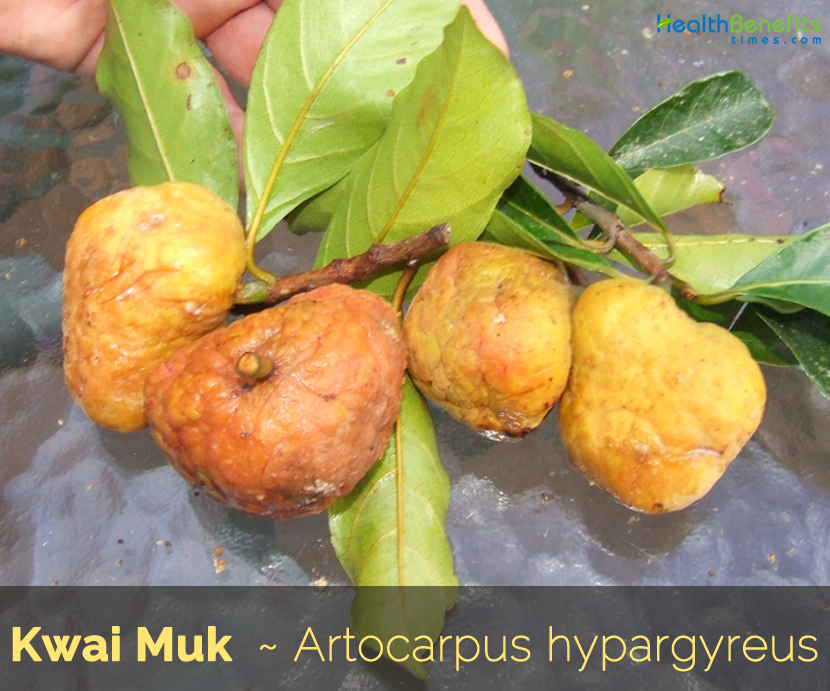| Kwai Muk Quick Facts | |
|---|---|
| Name: | Kwai Muk |
| Scientific Name: | Artocarpus hypargyreus |
| Origin | Sothern China, in Hong Kong, Fujian, Guangdong, Guangxi, Hainan, South Hunan, Jiangxi and southeast Yunnan |
| Colors | Pale green turning to pale yellow to golden yellow |
| Shapes | Irregular that are globose, ovate, or oblate having diameter of 1.5-2 inches |
| Flesh colors | Dark pink to orange-red |
| Taste | Pleasant, slightly sour taste |
Plant description
Kwai Muk is a fairly slow-growing evergreen tree that grows about 10–15 m (33–49) tall mature trees in Florida generally attains a height of 20-25 ft. The canopy is rounded and dense, with a width approximately equaling its height. The plant is found growing in most soils provided they are well-drained, but thrives best in mildly acid sandy soils. It will grow in calcareous soils but do suffer from chlorosis associated with iron, manganese and zinc deficiencies. Trunk is normally 40cm in diameter with dark purple, exfoliating barks. Twigs are greyish and puberulent and stipules caduceus and linear.
Leaves
The leaves are simple, elliptic to elliptic-ovate, 3-6 inches long, with a stiff, leathery texture, acuminate tips and entire margins. They are shiny and dark green on the upper surface and dull medium green on the lower surface; both surfaces are glabrous. The tree retains its leaves throughout the year and has an attractive appearance at all times. The stems, leaves and green fruits exude white, sticky latex when they are cut or broken.
Flower
The yellowish male and female flowers are borne in solitary, axillary, obovoid, separate inflorescences on the same tree. Minute flowers are joined and the inflorescence develops into a multiple fruit, a syncarp. Flowering occurs from May to July.
Fruit
The fruit have a diameter of 1.5-2 inches and a weight of 0.5-1.5 oz. Fruit shape is irregular, being globose, ovate, or oblate. The skin is thin and easily broken. It is yellow at ripeness and covered with a fine, soft, short pubescence. The pulp is orange-red to red, very soft and tender, with a pleasant sub acid flavor. The fruit ripens from August to October. No yield records are available, but mature trees have the capability of producing 2000 fruit or more per year.
The fruit have 1-7 seeds, the number apparently affecting the size and shape of the fruit. Isolated trees often bear many small, seedless fruit, suggesting that the tree is self-incompatible and needs cross-pollination to produce viable seed and fruit of normal size. The seeds are whitish and ovoid, with a diameter of 0.3- 0.4 inch. Propagation has been done in Florida entirely by seed. Seed take several weeks to germinate and the young plants grow slowly. No research has been done on cultivar selection or vegetative propagation in Florida.
History
The Kwai muk is native to southern China, where it grows wild in Kwangtung Province, on Hainan Island, and in Hong Kong. Tree is occasionally cultivated in Southeast Asia but rarely elsewhere in the tropics. Although best adapted to a moist, warm, subtropical or tropical climate, the Kwai muk can withstand light frosts.
Culinary Uses
- Ripe fruit has an excellent flavor and is eaten fresh or preserved with salt or sugar syrup.
- Fruit can be dried; dried fruit still retains the good texture and flavor.
- Fruit can also be dried or preserved in syrup.
Other Facts
- Stem and leaves exude white latex when bruised.
- Tree is small and attractive and lends itself well to landscaping on small urban properties.
- Milky latex is used for making stiff rubber and the wood for furniture.
- Wood is used for making furniture.
- Kwai muk makes an attractive ornamental for landscaping in larger gardens.
- Prolic tree can produce more than 2,000 fruits per tree, per season.
References:
https://davesgarden.com/guides/pf/go/102549/
https://npgsweb.ars-grin.gov/gringlobal/taxonomydetail.aspx?id=4329
http://rfcarchives.org.au/Next/Fruits/Jakfruit/KwaiMuk11-87.htm
https://en.wikipedia.org/wiki/Artocarpus_hypargyreus
Comments
comments
